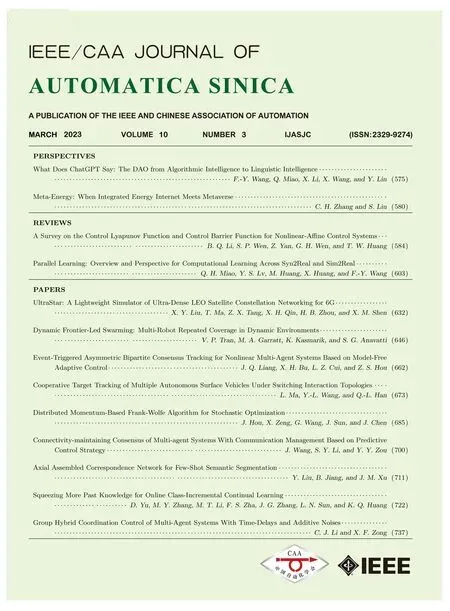Event-Triggered Asymmetric Bipartite Consensus Tracking for Nonlinear Multi-Agent Systems Based on Model-Free Adaptive Control
2023-03-27JiaqiLiangXuhuiBuLizhiCuiandZhongshengHou
Jiaqi Liang, Xuhui Bu,, Lizhi Cui, and Zhongsheng Hou,
Abstract—In this paper, an asymmetric bipartite consensus problem for the nonlinear multi-agent systems with cooperative and antagonistic interactions is studied under the event-triggered mechanism.For the agents described by a structurally balanced signed digraph, the asymmetric bipartite consensus objective is firstly defined, assigning the agents’output to different signs and module values.Considering with the completely unknown dynamics of the agents, a novel event-triggered model-free adaptive bipartite control protocol is designed based on the agents’triggered outputs and an equivalent compact form data model.By utilizing the Lyapunov analysis method, the threshold of the triggering condition is obtained.Subsequently, the asymptotic convergence of the tracking error is deduced and a sufficient condition is obtained based on the contraction mapping principle.Finally, the simulation example further demonstrates the effectiveness of the protocol.
I.INTRODUCTION
MULTI-AGENT systems consist of self-governing agents to collaboratively achieve a complex task, based on their distributed communication and flexibility ability to learn and make autonomous decisions.Therefore, the collaboration control for the multi-agent systems draws attention.An important problem in distributed coordination is to develop information flow algorithms or protocols, which specify the information exchange between an agent and its neighbors, such that the group as a whole can reach an agreement regarding a certain quantity of interest.This problem is usually termed consensus or synchronization problem [1]–[3].For islanded microgrid systems, the distributed generators were communicated to reach frequency restoration as well as achieve voltage regulation with respect to the primary control strategy [4].In [5], the scheduling and platooning control for automated vehicles was investigated based on a consensus principle.In [6], the distributed filtering problem was solved for lager-scale systems under cyber-attacks and noises.But considering the networkinduced problems [7], the interaction between agents may be exchanged instantaneously, and it is difficult to keep fixed posture.Driving the agents to reach a consensus under switching topologies [1], [2], [4], [8], [9] also attacks much attention.It is worth noting that most results are defaulted agents to interact cooperatively.
In practice, cooperative and antagonistic relationships commonly exist, such as trust or distrust in social network,duopoly in economic phenomena.In this case, the co-competitive links impact on the implement of the agents’collaboration.To this point, Altafini introduced a suitable notion of consensus for the integrator multi-agent systems [10], i.e.,bipartite consensus, where the graph theory is also used to describe the complex cooperative and antagonistic links with their edges being positive or negative weighted.Under such a communication graph with bipartition property, called a signed graph, the agents trend in opposite directions with the same module value, while they will converge to zero with structural balance constraint breaks up.Considering the singed graph is matrix-weight-based, the bipartite consensus problem of the agents was studied in [11].Under a loosen connectivity assumption on the graph, an interval bipartite consensus control was investigated in [12].But the results mainly focus on a symmetric bipartite consensus convergence [13]–[16].In practice, there are asymmetrical consensus requirements, such as force feedback control in the multilateral teleoperation systems, the provided force needs to be adjusted with different masses of the equipment [17], [18], and the lower limb rehabilitation robot for training patients will provide different assistances or resistances, when considering the different muscle strengths of the two legs [19], [20].How to meet this asymmetric demand motivates the exploration of this paper at first aspect.
On the other hand, the communication resources among the agents are usually assumed abundant while the inherent bandwidth limitation of the network naturally exists.To achieve the collaborative control in a resource-efficient manner, eventtriggered control has been deeply researched by reducing controller update numbers or avoiding the continues communication.In [21]–[23], the event-triggered average consensus algorithms are developed to reduce the number of actuator updates.For avoiding continuous communication, a sate-independent event function is designed [24] and a distributed sampled-date-based event-triggered mechanism is proposed in[25].Considering the cooperative and antagonistic interactions, the event-triggered bipartite consensus control algorithms are proposed for the agents under the undirected graph in [26]–[28] and digraph in [29] and [30], respectively.However, precise models or known structures play key roles in the implementation of the event-triggered controller design,which enables the second motivation of this paper.
In fact, establishing the precise mathematical model of the systems is time-consuming and laborious, and also brings accompanying unmodeled dynamics and robustness issues,which leads to the control design going to complex and inapplicable for dealing with engineering problems, especially when network-induced issues coexisting [7], [31].Therefore,data-driven control, such as adaptive fuzzy control [32], adaptive neural network (NN) control [33], reinforcement learning control [34], and iterative learning control [35] techniques has been developed for the control designs independent of the system model.Corresponding to the crucial needs of the above methods, fuzzy rules, neural network models, and the same initial value, the realization depends on the neural network,which more or less cannot be applied to the actual control design requirements of simple structure and strong applicability.Nevertheless, model-free adaptive control (MFAC), as a data-driven approach, can be used to solve the control problems of nonlinear systems [36] or multi-agent systems [37]with completely unknown dynamics.Considering with limited network resources, the event-triggered MFAC designs are addressed to solve the control problem of single systems in[38]–[40], where the observer error-dependent threshold function is constructed in [38] and the estimation parameters related threshold function are established in [39] and [40].It is worth noting that the event-triggered MFAC designs only involve the output of a single nonlinear system.For the multiagent agents, based on the tracking error term as a threshold function, the event-triggered model-free adaptive learning consensus control is proposed in [41], in which the graph is undirected, connected and non-negative.That is the connectivity condition is strong and the relationships among the agents are considered to be all cooperative.Besides, the desired output may be available for all the agents to work the event detection.To the best of our knowledge there are still few studies on the event-triggered bipartite consensus control by the MFAC method, especially further exploring the control under a weak connectivity digraph.This is the third aspect of this paper.
Therefore, the asymmetric bipartite consensus tracking control for the nonlinear multi-agent systems is considered in this paper, where the signed graph is assumed to be structurally balanced and directed.Firstly, the asymmetrical bipartite objective is defined.By employing the triggering outputs of the agents and the signed digraph information, the event-triggered MFAC protocol is proposed.The main contributions of this paper are summarized as follows:
1) A new control problem for the multi-agent systems is considered, where the existing results on the consensus control of cooperative and antagonistic interactions agents were focused on the how-to ensure the agents converge to a symmetric bipartite consensus.
2) The completely unknown nonlinear multi-agent system with a weakly connection topology is considered.For that, the existing bipartite consensus model-based results, as well as asymmetric results in [42] and [43] are not suitable.Compared with the results of the existing MFAC schemes, the strong connection assumption is released as the weak connection condition except considering the cooperative and antagonistic interactions between agents.
3) An event-triggered data-driven control protocol is proposed only employing the agents’input/output (I/O) data at the triggering time instants.From a resource-efficient viewpoint, the outputs of the agents under event-triggered mechanisms are used to construct the input update law, simultaneously, a distributed event-triggered condition is given based on the outputs.Compared with the well-explored event-triggered control design, the scheme in this paper is totally datadriven.
The rest parts of this paper are organized as follows.In Section II, the graph theory and the control problem are stated,where the asymmetric bipartite consensus tracking objective is defined and an equivalent data model is established.In Section III, the event-triggered bipartite MFAC protocol is proposed.In Section IV, the selection of the triggering threshold and theoretical analysis of the tracking error convergence are given.Finally, the numerical example and the conclusion are respectively reported in Sections V and VI.
II.PRELIMINARIES AND PROBLEM FORMULATION
A.Preliminaries


B.Problem Formulation
Consider the discrete-time nonlinear multi-agent systems withNagents, where theith agent is described as
whereyi(k)∈R is the output of theith (i∈V) agent at thek∈{1,2,...} time instant andui(k)∈R is the corresponding input.The nonlinear functionfi(...) is unknown smooth function.The integersnyandnuare two unknown constants,which indicate that the order of the agents is unknown.
The considered communication graph satisfies the following assumption.
Assumption 1:The signed directed graph G=(V,E,A) is structurally balanced and assumed to have a spanning tree.
For the multi-agent systems (1) with signed digraph satisfying the Assumption 1, the asymmetrical bipartite consensus objective is defined as follows:
Objective: Given a desired trajectoryyd(k) to which only a portion of the agents have access, the objective is let outputs of the agents reach

Remark 2:As for the asymmetric objective (2), the process of the lower limb rehabilitation robots training for the patient will be a practical scenario [20].Since the auxiliary torques that the robots should provide to the left and right legs are not equal, there is a certain scaling and assistance/resistance relationship relative to the expected force (or trajectory) [19].Therefore, it is meaningful to explore how to reach such a bipartite consensus objective concerning an asymmetric state.Particularly, the well-explored bipartite consensus control is a special case of the asymmetric bipartite consensus when settingm=1.
Since the nonlinear dynamics of the agent is completely unknown, the following assumptions are needed to implement dynamic linearization technology.
Assumption 2:The partial derivative of the functionfi(...) is continuous with respect to the (ny+2)th variable for allk.
Assumption 3:Each agent in (1) satisfies the generalized Lipschitz condition, namely, for time instantsk+1,k≥0 andui(k+1)≠ui(k), there exists a constantb>0 such that
where ∆yi(k+ 1) =yi(k+1) −yi(k) and∆ui(k) =ui(k)−ui(k−1).
Then the following data model can be obtained.
Theorem 1 [36], [37]:For the nonlinear systems (1) satisfying the Assumptions 2 and 3, there exists a time-varying parameter called pseudo partial derivative (PPD)ϕi(k)∈R such that the systems (1) can be equivalently transformed into the following compact-form dynamic linearization (CFDL)data model
where | ϕi(k)|≤bis bounded ∀kandi∈V.
From a resource-efficient viewpoint, an event-triggered communication mechanism is also considered, then the task is to design an appropriate control protocol such that the nonlinear multi-agent systems can reach the objective with decreasing the communication numbers of the agents.
III.THE EVENT-TRIGGERED BIPARTITE MFAC DESIGN
Considering the cooperative and competitive relationships among the agents, a consensus error ξi(k) is constructed based on the objective (2)

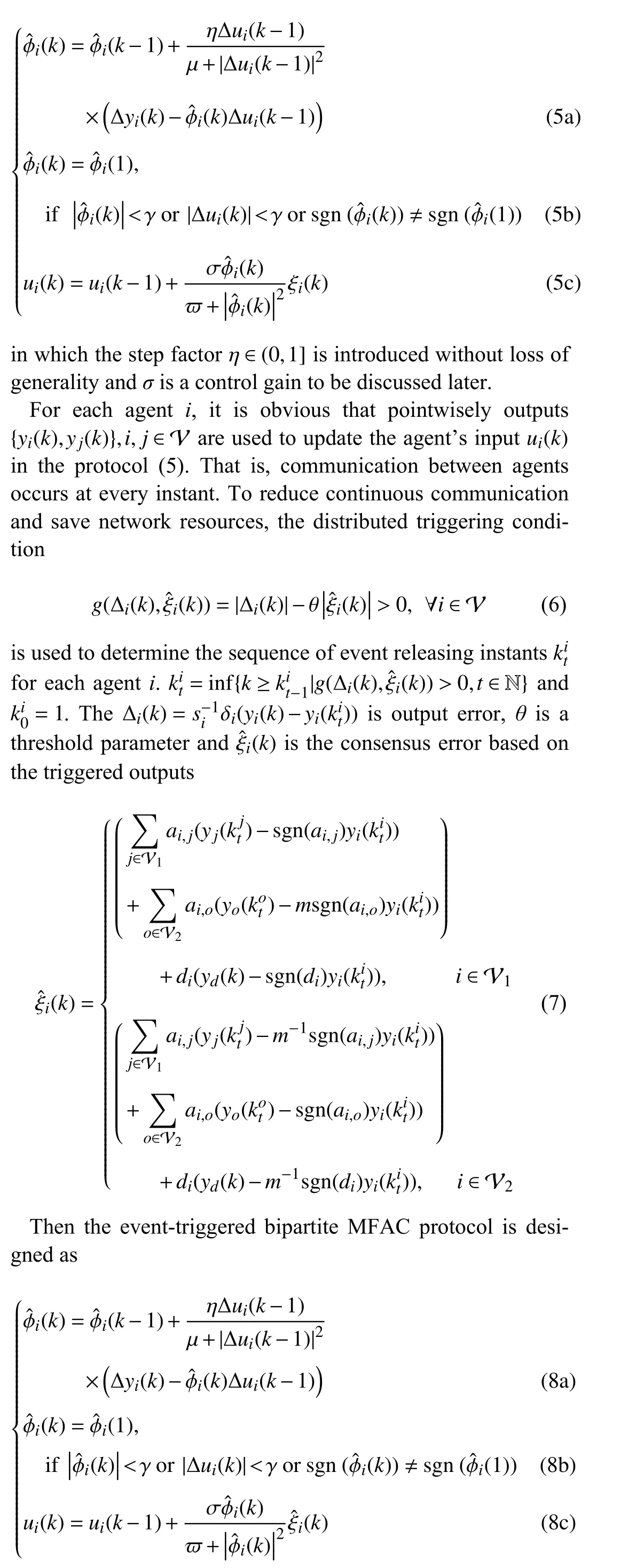
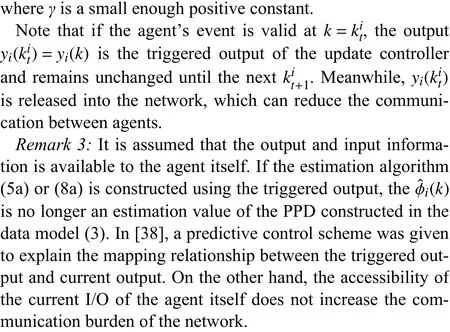
IV.MAIN RESULTS
In this section, the threshold of the event-triggered condition is firstly derived and the convergence theorem deduces after.
Define the tracking error based on the objective (2)


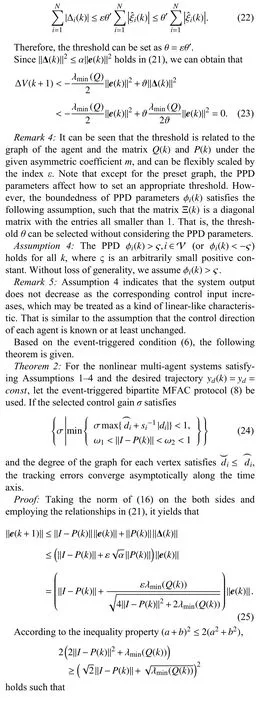
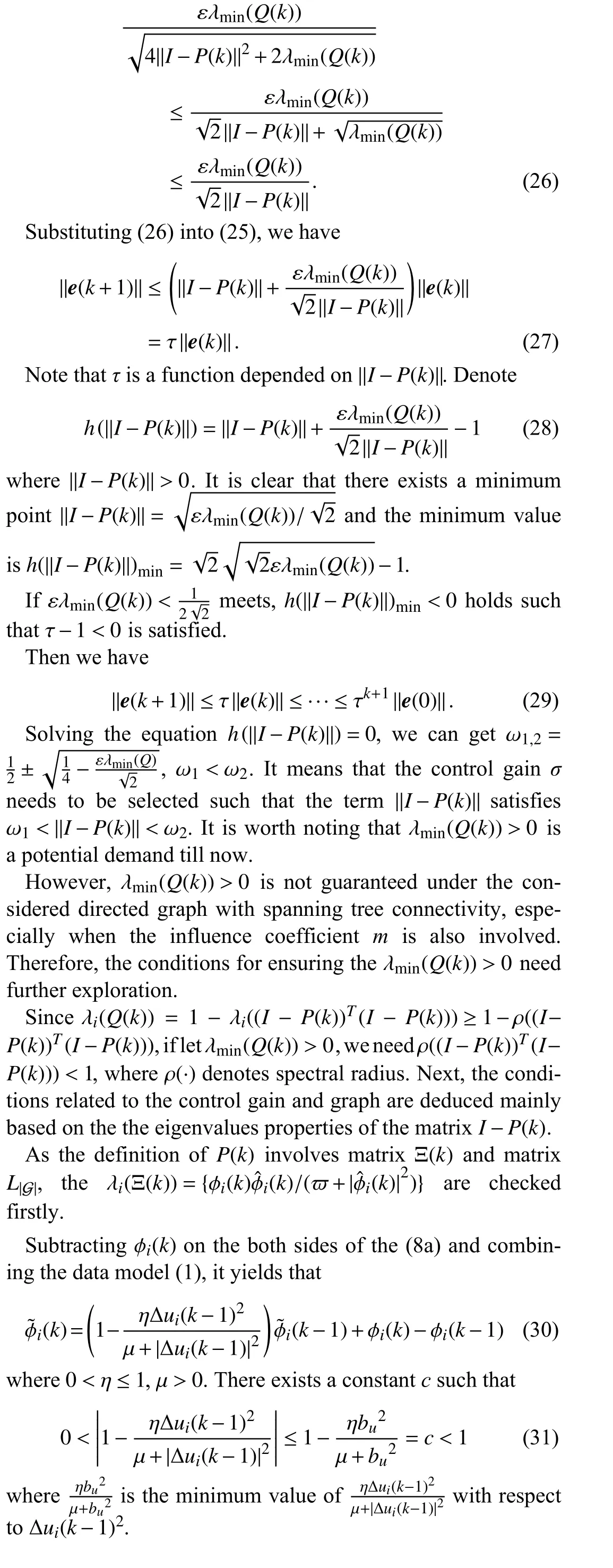




V.NUMERICAL EXAMPLE
In this section, numerical example is provided to illustrate the results.Firstly, the models of 8 agents are given to produce the nonlinear data flow as follows:


Fig.1.The communication directed graph of the networked agents.


Fig.2.The asymmetric bipartite profiles of the agents.

Fig.3.The tracking error of the agents.

The total communication numbers of 8 agents along the time axis are shown in the Fig.4.In order to intuitively indicate the number of triggering events, Table I shows the comparison of triggering numbers/operation numbers (T/O) of the agents.Obviously, the number of interactions is reduced under the designed event-triggered protocol, that is the network resources is saved.
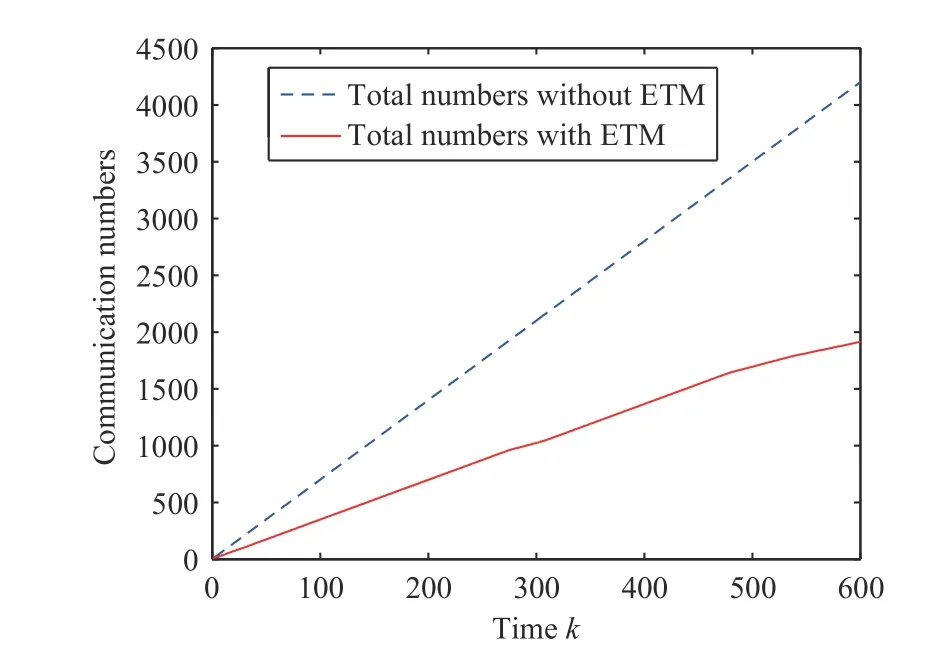
Fig.4.The total communication numbers of the 8 agents.

TABLE I THE TRIGGERING NUMBERS VS THE OPERATION NUMBERS
In Fig.5, the convergence conditionω1<‖I−P(k)‖<ω2<1 is also demonstrated.It is shown that the selectedσcan guarantee the norm within the two solutions, indicating that the selected control parameterσis appropriate.Moreover, the curve of minimum eigenvalue of the matrixQ(k) is also given in Fig.6, in which λmin(Q(k))>0 holds along the time axis.

Fig.5.The verification of convergence condition of ‖ I−P(k)‖.

Fig.6.The λ min(Q(k)) along the time axis.
From the results, it is indicated that the proposed MFAC can ensure the nonlinear agents reach the asymmetric bipartite consensus tracking objective under the event-triggered communication environment.Moreover, the protocol only depends on the triggered outputs and inputs of the agents, which demonstrates the proposed control method is totally a datadriven design.
VI.CONCLUSION
In this paper, the asymmetric bipartite consensus tracking control over the completely unknown nonlinear multi-agent systems has been studied, and the distributed event-triggered communication mechanism is also considered.To achieve the task under cooperative and competitive interactions, the asymmetric bipartite consensus objective has firstly been defined for the agents.Based on the triggered outputs and local inputs,the event-triggered MFAC bipartite control protocol has been proposed.With constructing the mapping relationships between the output error and the tracking error, the system asymptotic convergence has been ensured based on sufficient conditions, which are independent of the time-varying parameters and dependent on the digraph.Since the considered digraph is signed and weakly connected, the out-degree of a class of signed digraphs is not greater than the in-degree is required.Meanwhile, the asymptotic convergence is gradually transmitted to the derivation on ensuring λmin(Q(k))>0.The results show that the proposed MFAC protocol can ensure the agents reach the asymmetric bipartite consensus tracking goal without the accurate models of the agents and can decrease the communications of the agents in a resource-efficient viewpoint.However, there exist kinds of networkinduced problems, such as network security, delay, etc, therefore how to apply more situations under the network environment by employing the MFAC scheme needs further work.
杂志排行
IEEE/CAA Journal of Automatica Sinica的其它文章
- Current-Aided Multiple-AUV Cooperative Localization and Target Tracking in Anchor-Free Environments
- UltraStar: A Lightweight Simulator of Ultra-Dense LEO Satellite Constellation Networking for 6G
- Multi-AUV Inspection for Process Monitoring of Underwater Oil Transportation
- Process Monitoring Based on Temporal Feature Agglomeration and Enhancement
- Parallel Learning: Overview and Perspective for Computational Learning Across Syn2Real and Sim2Real
- Finite-Horizon l2–l∞State Estimation for Networked Systems Under Mixed Protocols
